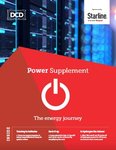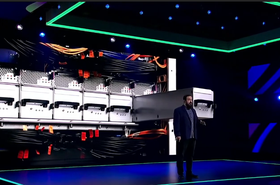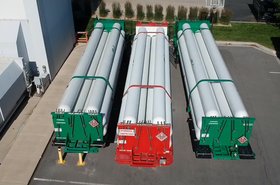While downsizing may be considered a dirty word for many in the IT sector, it’s time to break the taboo and finally ask ‘is bigger really better?’ Uninterruptible power supplies (UPS) provide us with a perfect scenario - often being the data center’s last line of defence during a power cut, responsible for ensuring both service continuity and protecting it from expensive, reputation wrecking downtime.
Historically IT teams have over-complicated UPS capacities in an attempt to deliver both peace of mind and a comfortable margin for error… but times have changed, so now with all eyes focussing on calls for greater resiliency and sustainability, someone has to challenge the thought process of consultants, owners and operators.
Battery upgrades on legacy UPSs, for example, are seen as a quick fix, while critical, or regular maintenance and service checks can often be overlooked. Isn’t it time for a change of rationale, some forward thinking, or if it weren’t for the endemic skills shortage, a change of personnel?
Recently, the 2020 Uptime Institute Data Center Survey reported that data center outages are occurring with disturbing frequency and becoming both more damaging and expensive. Furthermore, of the organizations surveyed, 75 percent stated that downtime was preventable with better management, processes or configuration, so isn’t it time that better technologies, even if they’re smaller, become part of that conversation?
Unlocking new opportunities
Today dramatic advances in technology are unlocking new opportunities to think smaller and smarter, and to challenge the status quo of what’s acceptable versus what’s achievable.
So, with greater pressure on IT leaders to rapidly adapt to a dynamically changing IT landscape, a fast-changing economic outlook and a greater appetite for digital transformation, how can consultants, engineers and design experts begin to change the focus towards longer lifecycle and a better ROI, versus ticking the box for procurement?
The fact is that whether it’s cloud, colocation or Covid-19 driving the decision to deploy new critical infrastructure, it should always be focused on better outcomes – from the power, cooling and mission-critical IT systems all the way to the hosting and application layers. Right-sizing UPSs is a great place to start, but there are far better ways to rescale and downsize the power system, while ensuring resiliency.
Building-in unnecessary capacity
When carried out correctly, downsizing the UPS shows how IT leadership teams can make decisions that are smart, cost-effective and efficient. It also shows they know how to unlock agility in their department and seize fresh opportunities as they arise.
Yet for many years IT departments have over-specified their UPS to gain additional resiliency, peace of mind and a comfortable margin for error. However, as we’ve seen recently, when an outage happens in a large facility (and boy does it happen!) that peace of mind can be shattered. And often this can be from a lack of due diligence, rather than the design or an N+1 configuration.
The justification for upsizing or building in additional capacity previously worked on two levels; the first enables future growth. For example, if a data center draws 50kW, but the operator predicts it will double in three years, a 100kW UPS might seem the best choice to accommodate expansion.
However, this means the system could potentially be wasting 50 percent of its capacity for years – a situation further compounded by its inherent ability to leak electricity and waste money. Here, a better solution would be to recommend a 100kW modular UPS, configured with 50kW power modules, so that the customer can scale up incrementally in the most cost-effective and efficient way possible, when they need it.
However, that causes another conundrum where procurement is concerned. Modular UPS systems often require a larger upfront investment. However, because they recapture the cost by offering greater energy efficiency and scalability, a business may be more open to an argument for lower long-term operating expenses (OpEx) versus the immediate capital expenditure (CapEx).
Traditionally IT departments have, somewhat prematurely, expanded their UPS to ensure they have enough capacity for when disaster strikes - which would be fine if the margin of comfort was reasonable. However, successive stakeholders involved in the procurement process can often over specify, so the final system ends up being too big for the job - adding extra capacity ‘just to be on the safe side’.
We believe that rather than over-size, or even right-sizing UPS capacity, IT leaders should be actively looking for opportunities to harness the latest technology and downsize their UPS.
Downsizing is not the risky exercise it may once have been and UPS technologies have evolved to mean that users can confidently utilize a smaller system, safe in the knowledge that they’re reducing costs, stripping out complexity and reducing physical footprint, without increasing risk.
For example, an IT department looking to buy replacement batteries for a five-year-old UPS, should carefully weigh up the benefits of switching to a modern, downsized UPS. This approach would offer enhanced safeguards, lower cost of ownership, enhanced energy efficiency, more effective use of capacity and greater reliability. Here the energy savings alone could be as much as 10 to 15 per cent, not to mention other benefits such as improved performance.
Data driven insights
We also believe that UPS should be smarter and better managed, rather than simply being more powerful. Some of the most up-to-date models now use artificial intelligence (AI) and data analytics to predict when their batteries will fail, providing recommendations to improve the health and lifespan, saving both money and avoiding downtime.
Remote monitoring is also crucial. A UPS may lay unused for weeks or months at a time, but when there is a power failure, they need to activate within milliseconds to avoid disruption. This means that the ability to monitor your critical infrastructure in real time ensures they’re fighting fit and will perform exactly when they’re needed.
The latest UPSs prove that bigger is not necessarily better and that smaller, smarter and more efficient solutions provide a far more optimal and value-add solution for data center operators. Today it’s clear that organizations can no longer justify over-spending and complicating their critical power systems on a financial or environmental level. From a power perspective there is no longer a need to size UPS capacity in the traditional way.





